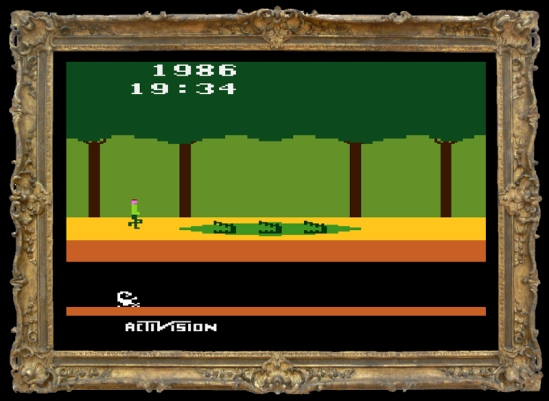
Here’s my position paper for the “Game Studies as Media Studies” panel at the FLOW Conference 2012 in Austin, Texas (November 1-3).
Ludic Serialities and the “Parergodicity” of Game Studies as Media Studies
Shane Denson, Leibniz Universität Hannover
The topic of this panel, “Game Studies as Media Studies,” challenges us to stipulate relations (however tentatively) between two fields of study that are themselves in many ways intersectional, cross-disciplinary, and thus to a certain extent undefined. Indeed, by broaching this topic we are returned to the (self-proclaimed) inaugural moment of game studies: to the debates raging as Espen Aarseth famously announced, in 2001’s premiere issue of the online journal Game Studies, “Year One” of computer game studies. In his attempt to stake out the terrain for “a new discipline” and protect it from “colonising efforts” from film and literary studies, Aarseth declared games’ independence from “old mass media, such as theatre, movies, TV shows and novels.” Already eleven years ago, then, Aarseth rejected the idea of game studies as media studies, writing: “Some would argue that the obvious place for game studies is in a media department, but given the strong focus there on mass media and the visual aesthetics, the fundamentally unique aspects of the games could easily be lost.”
The background, of course, was the so-called narratology-versus-ludology debate. And though that debate has since subsided (to the point, even, that some question whether it ever took place at all; cf. Frasca 2003), many of the central points of contention inevitably arise again when we undertake to reassess the relations between game studies and media studies. The crux, of course, is the ludological idea that the defining feature of games as a medium, and hence the core concern of game studies, is the interactive or, in Aarseth’s (1997) term, “ergodic” situation of gameplay – where ergodics combines the Greek ergon (work) and hodos (path), thus positing nontrivial labor as the aesthetic mode of players’ engagement with games. From a ludological perspective, narrative then appears as marginal, subordinate, or at best supplementary or parallel to gameplay – hence para- or “parergodic,” as I propose calling it. And not just narrative, but many of the aspects that might interest media scholars occupy this marginal or framing field of parergodics: from visual forms on screen, for example, to the social and cultural formations they give rise to in the wider world, outside the games themselves.
But parergodicity, a term which combines Aarseth’s “ergodics” with Derrida’s (1987) “parergon,” is not clearly distinguishable from the core of ergodics; on the contrary, the parergodic enacts a logic of supplementarity, a multistable oscillation such as Derrida ascribes to the picture frame: standing outside the work and serving as its background, the frame can also shift and become part of the figure when seen against the background of the wall. Parergodicity, I propose, defines a broad space for media studies research on games, allowing us more generally to rethink the relations between media studies and game studies so as to avoid both extremes of incommensurability and of colonization: “game studies as media studies,” conceived as a field of parergodic inquiry, aims at once to acknowledge the medial specificity of games, their resistance to paradigms established by studying dominant media like film and TV, without thereby ignoring the many empirical and conceptual points of contact that exist.
A key field of parergodic phenomena that demonstrates this potential is the widespread but undertheorized seriality that characterizes games at virtually every level of their material, cultural, and intermedial expression. While the serialization practices that generate ever new iterations of Mario, Zelda, or Lara Croft might seem to be clearly extraneous to the ergodic activity of gameplay, this is far from obvious. In the context of a joint project entitled “Digital Seriality: The Serial Aesthetics and Practice of Digital Games,” Andreas Jahn-Sudmann and I have identified three levels across which seriality can be seen to resonate. Most basically, seriality informs gameplay directly through formal-algorithmic structures of repetition/variation and the intra-ludic seriality of progressive game “levels” (which often repeat, and vary, the basic representational but also actional structures established in earlier levels, thus establishing both episodic closure and continuation). Sequels, remakes, and other explicit serialization practices constitute inter-ludic serialities that are operative between games, but not without consequence or relation to gameplay proper and its infrastructure (the modularity of game engines promotes inter-ludic serialization, for example, essentially repeating the serial patterning of intra-game levels). Moreover, fan practices and transmedial phenomena beyond the games themselves instantiate extra- or para-ludic serialities, which tie gameplay into larger networks of media consumption and exchange. As parergodic phenomena, ludic serialities therefore cut across the divisions that were taken to separate narratological and ludological positions. Finally, then, these serial structures offer both a broad basis for cross-media comparisons (from dime novels, film serials, TV series, etc.), as well as the means for identifying salient differences of digital interactivity, thus articulating a field of parergodics as the site of overlap, complementarity, and mutual advantage for game studies and media studies.
Works cited:
Aarseth, Espen J. 1997. Cybertext: Perspectives on Ergodic Literature. Baltimore: Johns Hopkins UP.
Aarseth, Espen J. 2001. “Computer Game Studies, Year One.” Game Studies 1.1 (July 2001): <http://www.gamestudies.org/0101/editorial.html>.
Derrida, Jacques. 1987. The Truth in Painting. Trans. Geoff Bennington and Ian McLeod. Chicago: U of Chicago P.
Frasca, Gonzalo. 2003. “Ludologists love stories, too: Notes from a debate that never took place.” Level Up Conference Proceedings. Utrecht: University of Utrecht. 92-99. <http://www.digra.org/dl/db/05163.01125>.
